
|
Government of Canada Response to the Public Order Emergency Commission Recommendations
|
The difficult but necessary measures taken by governments to keep Canadians safe from the spread of COVID-19 led to many hardships for Canadian families; many experienced impacts on mental health, separation from loved ones, friends and social networks, loss of employment, interrupted schooling and more.
| 2024-03-06 |

|
Advancing the Federal-Provincial-Territorial Emergency Management Strategy: Areas for Action
|
The 2021-22 Federal, Provincial, and Territorial Emergency Management Strategy Interim Action Plan, the first in a series of action plans to 2030, will advance defined outcomes within the Emergency Management Strategy for Canada, and demonstrate concrete steps that federal, provincial and territorial governments, and respective emergency management partners, intend to take to advance resilience to disasters.
| 2024-02-21 |
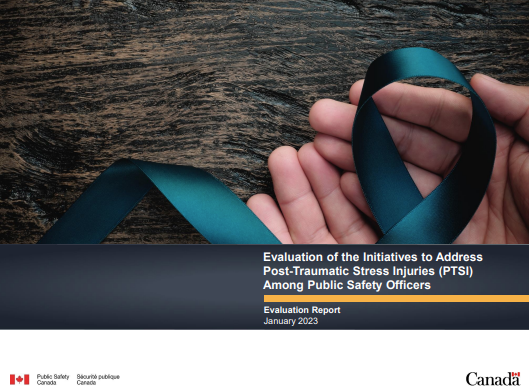
|
Evaluation of the Initiatives to Address Post-Traumatic Stress Injuries (PTSI) Evaluation Report
|
The evaluation covered the Initiatives' activities under the Contribution Agreement with CIPSRT from January 2019, when the agreement was signed, to April 2022.
| 2023-05-29 |

|
Summary of the Evaluation of the Initiatives to Address Post-Traumatic Stress Injuries (PTSI) Among Public Safety Officers
|
Public safety officers play a critical role in keeping Canadians safe, which often exposes them to traumatic incidents that can lead to post-traumatic stress injuries (PTSI).
| 2023-05-29 |
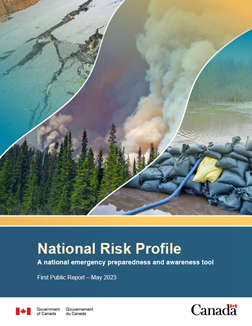
|
The First Public Report of the National Risk Profile
|
This report is based on input and evidence from whole-of-society stakeholders across Canada, and provides a foundation for understanding disaster risk from the three costliest hazards facing Canadians: earthquakes, wildland fire, and floods.
| 2023-05-11 |

|
The National Search and Rescue Secretariat 406 megahertz (MHz) Personal Locator Beacon
|
This document contains the minimum requirements for the functional and technical performance of Personal Locator Beacons (PLBs) operating in the 406.0 to 406.1 megahertz (MHz) band through low earth polar-orbiting, medium earth orbiting and geostationary satellite systems.
| 2023-03-01 |

|
Canada's Midterm Review of the Implementation of the Sendai Framework for Disaster Risk Reduction 2015-2030
|
Canada's submission to the United Nations Office of Disaster Risk Reduction on its national progress to implement the Sendai Framework for Disaster Risk Reduction was developed as a whole-of-government report, including contributions from departments and agencies across the Government of Canada.
| 2022-10-28 |

|
The Memorial Grant Program for First Responders: Awareness Brochure
|
The Memorial Grant Program for First Responders recognizes the service and sacrifice of responders in keeping Canadians safe.
| 2022-09-07 |
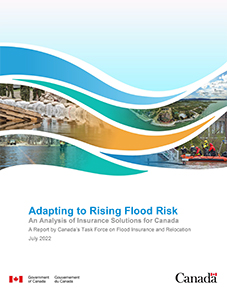
|
Adapting to Rising Flood Risk - An Analysis of Insurance Solutions for Canada
|
The report seeks to provide a common understanding of the evidence and information required to implement viable arrangements for a national approach to flood insurance, with special considerations for potential strategic relocation of those at most extreme risk.
| 2022-08-30 |
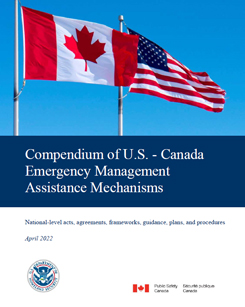
|
Compendium of U.S. - Canada Emergency Management Assistance Mechanisms
|
Under the auspices of the U.S.-Canada Emergency Management Consultative Group, Canada and the United States have, since 2012, maintained this Compendium of U.S.-Canada Emergency Management Assistance Mechanisms that catalogues various federal mechanisms governing emergency management within and across our two countries.
| 2022-04-04 |
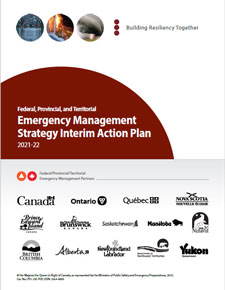
|
ARCHIVE - Federal, Provincial, and Territorial Emergency Management Strategy Interim Action Plan 2021-22
|
The 2021-22 Federal, Provincial, and Territorial Emergency Management Strategy Interim Action Plan, the first in a series of action plans to 2030, will advance defined outcomes within the Emergency Management Strategy for Canada, and demonstrate concrete steps that federal, provincial and territorial governments, and respective emergency management partners, intend to take to advance resilience to disasters.
| 2022-03-17 |
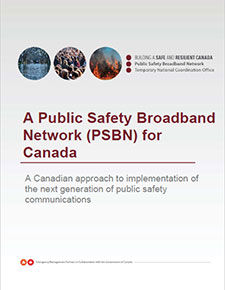
|
A Public Safety Broadband Network (PSBN) for Canada
|
A Canadian approach to implementation of the next generation of public safety communications
| 2022-03-17 |

|
Progress Report on a National Public Safety Broadband Network - Working towards the next generation of public safety communications in Canada
|
The Temporary National Coordination Office (TNCO) was established in July 2018 with a mandate to develop options and recommendations for a Public Safety Broadband Network (PSBN) for first responders and public safety personnel across Canada. The TNCO consulted stakeholders and field experts; examined research and literature available to date, as well as pilots and trials; and conducted analyses to develop the recommendations contained in this progress report.
| 2019-06-28 |

|
Supporting Canada's Public Safety Personnel: An Action Plan on Post-Traumatic Stress Injuries
|
Public safety officers put their lives on the line to keep others safe. It's part of the job description. While the rest of us try to get out of harm's way in a crisis, they run into the thick of it. The nature of that work exposes them to tough and traumatic events. It takes a toll.
| 2019-04-08 |
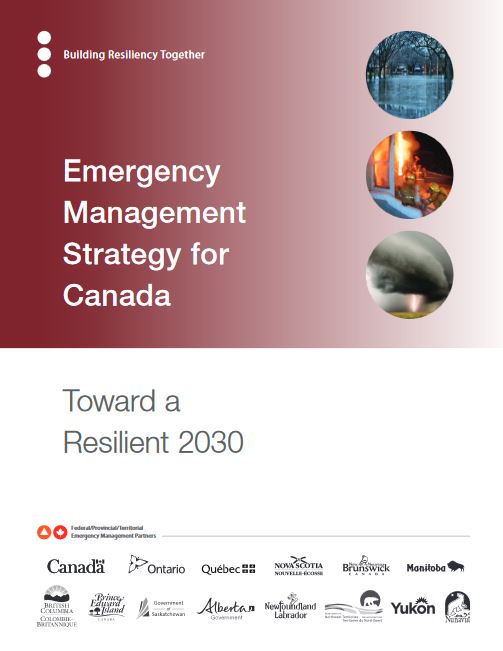
|
Emergency Management Strategy for Canada: Toward a Resilient 2030
|
The Emergency Management Strategy for Canada (EM Strategy) builds on the foundational principles articulated in the EM Framework and the Sendai Framework in order to establish FPT priorities to strengthen the resilience of Canadian society by 2030.
| 2019-01-25 |

|
An Emergency Management Framework for Canada - Third Edition
|
In Canada, emergency management adopts an all-hazards approach to address both natural and human-induced hazards and disasters.
| 2017-05-26 |

|
2016-2017 Evaluation of the Disaster Financial Assistance Arrangements
|
The Disaster Financial Assistance Arrangement program (DFAA) is a federal transfer payment program that provides financial assistance to a province/territory (PT) for a natural disaster that is declared a provincial/territorial emergency to be of concern to the federal government.
| 2017-04-04 |

|
Summary of the Evaluation of the Disaster Financial Assistance Arrangements Program
|
The Disaster Financial Assistance Arrangement program (DFAA) is a federal transfer payment program that provides financial assistance to a province/territory (PT) for a natural disaster that is declared a provincial/territorial emergency to be of concern to the federal government.
| 2017-04-04 |
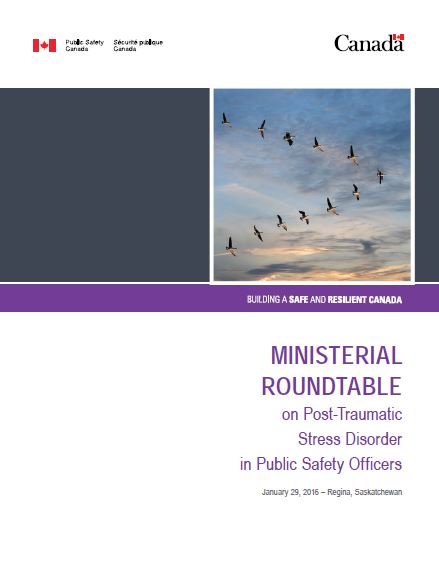
|
Ministerial Roundtable on Post-Traumatic Stress Disorder in Public Safety Officers
|
Public Safety Canada hosted a Ministerial Roundtable on January 29, 2016 at the University of Regina on the impacts of post-traumatic stress disorder (PTSD) on public safety officers. The roundtable brought together over 50 members of academia, not-for-profit organizations, union representatives and tri-service leadership (fire, police and paramedic), operational public safety officers, and all three levels of government to the table to discuss the threat posed by operational stress injuries (OSIs) affecting public safety officers.
| 2016-02-20 |
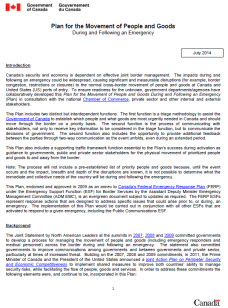
|
Plan for the Movement of People and Goods During and Following an Emergency
|
Canada's security and economy is dependent on effective joint border management. The impacts during and following an emergency could be widespread, causing significant and measurable disruptions (for example, border congestion, restrictions or closures) to the normal cross-border movement of people and goods at Canada and United States (US) ports of entry.
| 2014-10-20 |

|
Internal Audit of Financial Management Governance
|
This audit was approved by the Deputy Minister on May 23, 2013 as part of the Risk-based Audit Plan 2012-13 to 2014-2015. Public Safety Canada (PS) identified financial management governance as an area of interest warranting audit.
| 2014-09-22 |

|
Fourth Annual Roundtable Canada's Platform for Disaster Risk Reduction
|
The purpose of this annual event is to make Canadians safer by reducing risks, making communities more resilient and partnering with all levels of government, universities, professional associations, voluntary organizations and the general public.
| 2014-09-12 |

|
Internal Audit of Emergency Management Planning: Leadership and Oversight
|
Under Section 3 of the Emergency Management Act (EMA), the Department of Public Safety and Emergency Preparedness is responsible for providing government-wide leadership and oversight over the emergency management (EM) activities of federal institutions – including their emergency management plans, which include the following instruments
| 2014-05-02 |

|
Third Annual Roundtable Canada's Platform for Disaster Risk Reduction
|
The purpose of this annual event is to make Canadians safer by reducing risks, making communities more resilient and partnering with all levels of government, universities, professional associations, voluntary organizations and the general public.
| 2014-04-04 |

|
Canada's National Disaster Mitigation Strategy
|
This Strategy is based on the recognition by federal, provincial, and territorial governments that mitigation is an important part of a robust emergency management framework, and that all stakeholders are committed to working together to support disaster mitigation in Canada.
| 2013-05-13 |
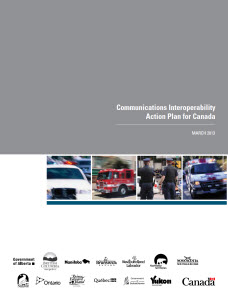
|
Communications Interoperability Action Plan Tasks, Sub-Tasks and Deliverables 2013-2014
|
The purpose of this Communications Interoperability Action Plan is to articulate the specific tasks assigned to each action item derived from the Communications Interoperability Strategy for Canada (CISC), including those items carried forward from the previous version of the 2012 Action Plan, the last Federal, Provincial, Territorial (F/P/T) Interoperability Sub-Working Group (IWG) meeting in Toronto, Ontario December 2012 and the Canadian Communications Interoperability Plan Working Group's last meeting in Windsor in September 2010.
| 2013-03-01 |

|
ARCHIVE - All Hazards Risk Assessment Methodology Guidelines 2012-2013
|
This document has been developed by Public Safety Canada, in close partnership with Defence Research and Development Canada - Centre for Security Science, as part of the federal All Hazards Risk Assessment initiative endorsed by the Assistant Deputy Minister Emergency Management Committee in October 2009.
| 2013-02-08 |

|
1st Annual Roundtable Canada's Platform for Disaster Risk Reduction
|
As the Advisory Committee for Canada's Platform for Disaster Risk Reduction, we are pleased to present you with the final report for the inaugural National Roundtable on Disaster Risk Reduction which took place in Fredericton, New Brunswick on October 26, 2010.
| 2012-10-23 |

|
North American Plan For Animal and Pandemic Influenza
|
The NAPAPI is a comprehensive cross-sectoral regional health security framework developed mainly with the input of the health, agriculture, security, and foreign affairs sectors to protect against, control and provide a public health response to animal and pandemic influenza in North America, while avoiding unnecessary interference with international travel and trade.
| 2012-04-03 |

|
Canadian Urban Search and Rescue (USAR) classification guide
|
Public Safety and Emergency Preparedness Canada (PSEPC) has the federal lead in developing Canada's capacity to rescue victims from major structural collapse or other entrapments. Urban Search and Rescue (USAR) is the general term for a group of specialized rescue skills supplemented by search, medical and structural assessment resources combined in a mobile, highly integrated team.
| 2012-03-22 |
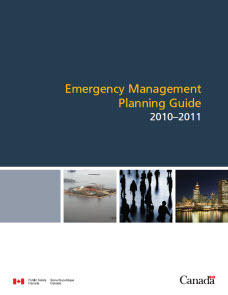
|
Emergency Management Planning Guide 2010–2011
|
Public Safety Canada has developed this Emergency Management Planning Guide, which is intended to assist all federal government institutions in developing their all-hazards Strategic Emergency Management Plans (SEMPs).
| 2012-02-20 |

|
Archived - All Hazards Risk Assessment Methodology Guidelines 2011-2012
|
This document has been developed by Public Safety Canada, in close partnership with Defence Research and Development Canada - Centre for Security Science, as part of the federal All Hazards Risk Assessment initiative endorsed by the Assistant Deputy Minister Emergency Management Committee in October 2009.
| 2011-12-01 |

|
2nd Annual Roundtable Canada's Platform for Disaster Risk Reduction
|
The purpose of this annual event is to make Canadians safer by reducing risks, making communities more resilient and partnering with all levels of government, universities, professional associations, voluntary organizations and the general public.
| 2011-10-18 |

|
Chemical, Biological, Radiological, Nuclear and Explosives Resilience Strategy for Canada
|
In order to enhance and sustain Canada's resilience to CBRNE events, all levels of government within Canada have collaborated to develop the Chemical, Biological, Radiological, Nuclear and Explosives Resilience Strategy for Canada
| 2011-01-01 |

|
Chemical, Biological, Radiological, Nuclear and Explosives Resilience Action Plan for Canada
|
The purpose of the Chemical, Biological, Radiological, Nuclear and Explosives (CBRNE) Resilience Strategy for Canada is to provide the policy framework that guides the creation and maintenance of sustainable capabilities, common standards and steers investments in CBRNE policies, programs, equipment, and training in a common direction.
| 2011-01-01 |

|
Communications Interoperability Strategy for Canada
|
The Communications Interoperability Strategy for Canada (CISC) is a strategic document that sets goals and identifies key national priorities to enhance governance, planning, technology, training and exercises to promote interoperable voice and data communications.
| 2011-01-01 |

|
An Emergency Management Framework for Canada
|
An Emergency Management Framework for Canada guides and strengthens the way governments work together to protect the safety and security of all Canadians.
| 2011-01-01 |

|
Federal Emergency Response Plan January 2011
|
The FERP is designed to harmonize federal emergency response efforts with those of the provinces/territorial governments, non-governmental organizations, and the private sector.
| 2011-01-01 |

|
National Emergency Response System
|
The National Emergency Response System is a component of Canada's emergency response management system and incorporates the principles for emergency management as set out in An Emergency Management Framework for Canada, approved by the federal, provincial and territorial governments.
| 2011-01-01 |

|
Federal Policy for Emergency Management
|
To promote an integrated and resilient whole-of-government approach to emergency management planning, which includes better prevention/mitigation of, preparedness for, response to, and recovery from emergencies.
| 2009-12-01 |

|
The Chemical, Biological, Radiological and Nuclear Strategy of the Government of Canada
|
The Chemical, Biological, Radiological and Nuclear Strategy of the Government of Canada defines CBRN as weaponized or non-weaponized chemical, biological, radiological and nuclear materials that can cause significant harm. Non-weaponized materials have been traditionally referred to as Dangerous Goods (DG) or Hazardous Materials (HAZMAT) and can also include contaminated food, livestock and crops.
| 2005-03-31 |